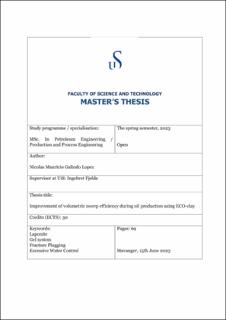| dc.description.abstract | Excess water production during oil production is a big challenge that may affect the economics and environmental concerns. Different methods have been developed to reduce water production and improve the efficiency of oil recovery. One promising approach is using a nanocomposite that creates a gel for plugging fractures in the reservoir. This system can potentially improve volumetric sweep efficiency during oil production by decreasing water permeability and creating a better path for the oil to flow to the well.
This study investigates the potential of an ECO-clay system comprising Laponite and Hydrolyzed Polyacrylamide (HPAM) as a water conformance technique in fractured reservoirs. The investigation involves bulk experiments to screen different concentrations of clay and polymer, while also evaluating the effects of various ions and additives on gel performance. Promising systems are subsequently subjected to filtration tests to assess their suitability for gel placement into fractures. Ultimately, the goal was to identify the most effective gel system and conduct core flooding tests to evaluate its potential for plugging fractures and improving oil recovery.
Among the systems tested, two were selected for dynamic experiments: A Laponite S482-CaCl2 system and a nanocomposite system with HPAM addition. Both showed good results in the filtrations and floods, achieving a water permeability reduction of 19.6 and 5.3 times lower than the pre-treatment permeability respectively. Finally, the Laponite S482-CaCl2 system represented the most promising gel system for fracture plugging in chalk, because its higher permeability reduction.
These findings highlight the potential of the identified gel system for effectively addressing water production issues in fractured chalk reservoirs, thereby improving oil recovery efficiency, reducing water production and CO2 emission. To improve the understanding and implementation of these gel systems, further work is required in a more in-depth gel structure tests, long-term stability and performance evaluation, compatibility with other reservoir fluid study, and finally field-scale experiments and simulations. Addressing these issues will help create a reliable and cost-effective fractured reservoir water conformance technique. | |
